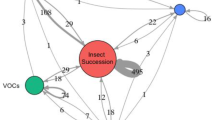Abstract
Stable isotopes are often used as natural labels to quantify the contributions of multiple sources to a mixture. For example, C and N isotopic signatures can be used to determine the fraction of three food sources in a consumer's diet. The standard dual isotope, three source linear mixing model assumes that the proportional contribution of a source to a mixture is the same for both elements (e.g., C, N). This may be a reasonable assumption if the concentrations are similar among all sources. However, one source is often particularly rich or poor in one element (e.g., N), which logically leads to a proportionate increase or decrease in the contribution of that source to the mixture for that element relative to the other element (e.g., C). We have developed a concentration-weighted linear mixing model, which assumes that for each element, a source's contribution is proportional to the contributed mass times the elemental concentration in that source. The model is outlined for two elements and three sources, but can be generalized to n elements and n+1 sources. Sensitivity analyses for C and N in three sources indicated that varying the N concentration of just one source had large and differing effects on the estimated source contributions of mass, C, and N. The same was true for a case study of bears feeding on salmon, moose, and N-poor plants. In this example, the estimated biomass contribution of salmon from the concentration-weighted model was markedly less than the standard model estimate. Application of the model to a captive feeding study of captive mink fed on salmon, lean beef, and C-rich, N-poor beef fat reproduced very closely the known dietary proportions, whereas the standard model failed to yield a set of positive source proportions. Use of this concentration-weighted model is recommended whenever the elemental concentrations vary substantially among the sources, which may occur in a variety of ecological and geochemical applications of stable isotope analysis. Possible examples besides dietary and food web studies include stable isotope analysis of water sources in soils, plants, or water bodies; geological sources for soils or marine systems; decomposition and soil organic matter dynamics, and tracing animal migration patterns. A spreadsheet for performing the calculations for this model is available at http://www.epa.gov/wed/pages/models.htm.
Similar content being viewed by others
Author information
Authors and Affiliations
Additional information
Electronic Publication
Rights and permissions
About this article
Cite this article
Phillips, D.L., Koch, P.L. Incorporating concentration dependence in stable isotope mixing models. Oecologia 130, 114–125 (2002). https://doi.org/10.1007/s004420100786
Received:
Accepted:
Published:
Issue Date:
DOI: https://doi.org/10.1007/s004420100786




